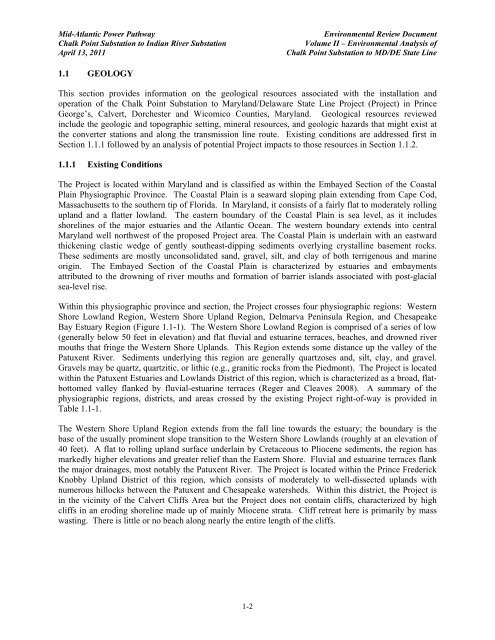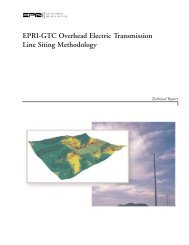Mid-Atlantic Power Pathway Chalk Point Substation to Indian River ...
Mid-Atlantic Power Pathway Chalk Point Substation to Indian River ...
Mid-Atlantic Power Pathway Chalk Point Substation to Indian River ...
You also want an ePaper? Increase the reach of your titles
YUMPU automatically turns print PDFs into web optimized ePapers that Google loves.
<strong>Mid</strong>-<strong>Atlantic</strong> <strong>Power</strong> <strong>Pathway</strong> Environmental Review Document<br />
<strong>Chalk</strong> <strong>Point</strong> <strong>Substation</strong> <strong>to</strong> <strong>Indian</strong> <strong>River</strong> <strong>Substation</strong> Volume II – Environmental Analysis of<br />
April 13, 2011 <strong>Chalk</strong> <strong>Point</strong> <strong>Substation</strong> <strong>to</strong> MD/DE State Line<br />
1.1 GEOLOGY<br />
This section provides information on the geological resources associated with the installation and<br />
operation of the <strong>Chalk</strong> <strong>Point</strong> <strong>Substation</strong> <strong>to</strong> Maryland/Delaware State Line Project (Project) in Prince<br />
George’s, Calvert, Dorchester and Wicomico Counties, Maryland. Geological resources reviewed<br />
include the geologic and <strong>to</strong>pographic setting, mineral resources, and geologic hazards that might exist at<br />
the converter stations and along the transmission line route. Existing conditions are addressed first in<br />
Section 1.1.1 followed by an analysis of potential Project impacts <strong>to</strong> those resources in Section 1.1.2.<br />
1.1.1 Existing Conditions<br />
The Project is located within Maryland and is classified as within the Embayed Section of the Coastal<br />
Plain Physiographic Province. The Coastal Plain is a seaward sloping plain extending from Cape Cod,<br />
Massachusetts <strong>to</strong> the southern tip of Florida. In Maryland, it consists of a fairly flat <strong>to</strong> moderately rolling<br />
upland and a flatter lowland. The eastern boundary of the Coastal Plain is sea level, as it includes<br />
shorelines of the major estuaries and the <strong>Atlantic</strong> Ocean. The western boundary extends in<strong>to</strong> central<br />
Maryland well northwest of the proposed Project area. The Coastal Plain is underlain with an eastward<br />
thickening clastic wedge of gently southeast-dipping sediments overlying crystalline basement rocks.<br />
These sediments are mostly unconsolidated sand, gravel, silt, and clay of both terrigenous and marine<br />
origin. The Embayed Section of the Coastal Plain is characterized by estuaries and embayments<br />
attributed <strong>to</strong> the drowning of river mouths and formation of barrier islands associated with post-glacial<br />
sea-level rise.<br />
Within this physiographic province and section, the Project crosses four physiographic regions: Western<br />
Shore Lowland Region, Western Shore Upland Region, Delmarva Peninsula Region, and Chesapeake<br />
Bay Estuary Region (Figure 1.1-1). The Western Shore Lowland Region is comprised of a series of low<br />
(generally below 50 feet in elevation) and flat fluvial and estuarine terraces, beaches, and drowned river<br />
mouths that fringe the Western Shore Uplands. This Region extends some distance up the valley of the<br />
Patuxent <strong>River</strong>. Sediments underlying this region are generally quartzoses and, silt, clay, and gravel.<br />
Gravels may be quartz, quartzitic, or lithic (e.g., granitic rocks from the Piedmont). The Project is located<br />
within the Patuxent Estuaries and Lowlands District of this region, which is characterized as a broad, flatbot<strong>to</strong>med<br />
valley flanked by fluvial-estuarine terraces (Reger and Cleaves 2008). A summary of the<br />
physiographic regions, districts, and areas crossed by the existing Project right-of-way is provided in<br />
Table 1.1-1.<br />
The Western Shore Upland Region extends from the fall line <strong>to</strong>wards the estuary; the boundary is the<br />
base of the usually prominent slope transition <strong>to</strong> the Western Shore Lowlands (roughly at an elevation of<br />
40 feet). A flat <strong>to</strong> rolling upland surface underlain by Cretaceous <strong>to</strong> Pliocene sediments, the region has<br />
markedly higher elevations and greater relief than the Eastern Shore. Fluvial and estuarine terraces flank<br />
the major drainages, most notably the Patuxent <strong>River</strong>. The Project is located within the Prince Frederick<br />
Knobby Upland District of this region, which consists of moderately <strong>to</strong> well-dissected uplands with<br />
numerous hillocks between the Patuxent and Chesapeake watersheds. Within this district, the Project is<br />
in the vicinity of the Calvert Cliffs Area but the Project does not contain cliffs, characterized by high<br />
cliffs in an eroding shoreline made up of mainly Miocene strata. Cliff retreat here is primarily by mass<br />
wasting. There is little or no beach along nearly the entire length of the cliffs.<br />
1-2




